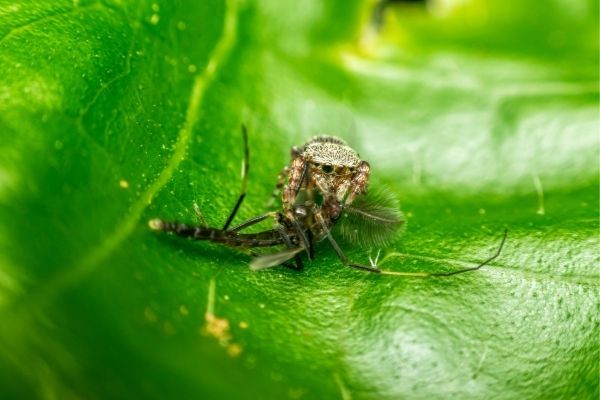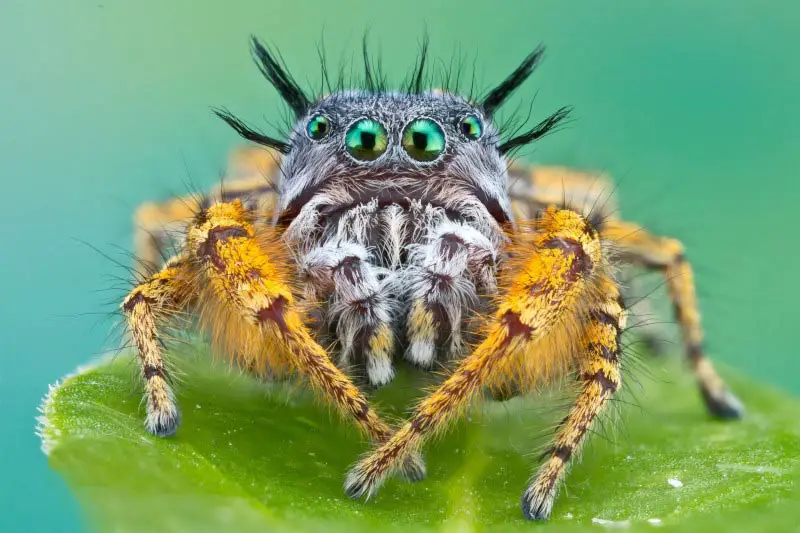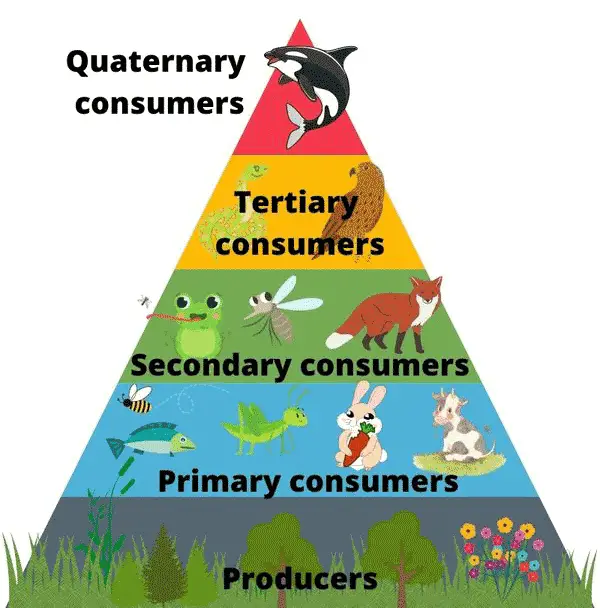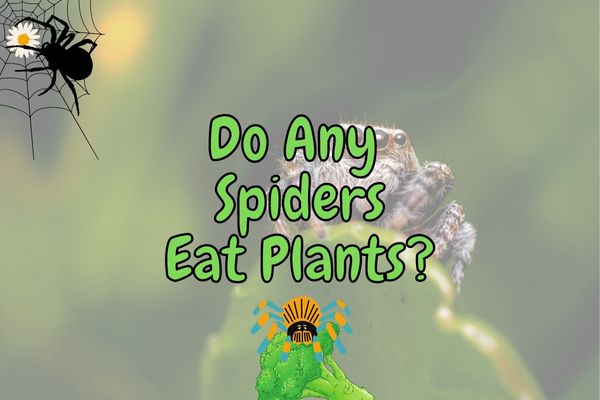Most spiders are predators that hunt and capture animal prey. They use their ability to spin webs to immobilize their victims before delivering a lethal bite. Some spiders, however, have adapted to a scavenging lifestyle and will eat dead insects instead of hunting live prey.
Spiders are generally carnivores as they hunt and eat other insects and other smaller animals. However, some spiders like the species Bagheera kiplingi is known to be almost entirely herbivorous! This means that spiders as a group are actually omnivores, but most species are still considered pure carnivores.
Spiders belong to the group called “Arachnids”, which also includes scorpions and ticks, but they are not insects! However, Arachnids are closely related to insects but spiders have eight legs, which is more than the six legs that insects have.
If you are interested in the relations between spiders, insects and crabs and lobsters, I wrote an article recently about that topic on this blog.
Contents
Why are Spiders Important for the Ecosystem?
As predators, spiders play an important role in the ecosystem by maintaining the population of their prey.
Without spiders, the ground would be covered in insects and the air would be thick of flies! Who would prefer that over seeing a few spiders once in a while?!
By keeping the population of insects in check, spiders help to prevent crop damage and disease transmission. In addition, spiders serve as a food source for other animals such as birds and bats.

As consumers, spiders also help to recycle nutrients and energy within the ecosystem. By eating insects, they break down organic matter and return essential nutrients back into the soil which can then be used by plants. This process helps to keep the ecosystem healthy and balanced.
What are spiders and what do they eat?
Spiders are closely related to mites and ticks. Together, these arthropods form the Arachnida, one of the largest classes of Arthropoda (meaning “joint foot”).
The Arachnida are one of the oldest groups that are part of Arthropoda. Arthropods have been around for about 500 million years. The earliest arthropods may have been more similar to scorpions or horseshoe crabs (that are in fact more like spiders than crabs!).
The Arachnida are divided into two subclasses, the Acari (ticks and mites) and the Araneae (spiders).
Spiders, like all arachnids, have eight legs, two body parts (the cephalothorax and abdomen) and six or eight eyes.
The Araneae are also noted for their chelicerae (mouthparts), which contain two fangs, one of which is modified into a venom gland.
Spiders are predators that capture their prey. Spiders can use both their senses of sight and of touch to do this. But also their fine engineering of spider webs!
Spiders can be predators of many insects that infest our homes including mosquitoes, common house flies, bedbugs, cockroaches, and moths. However, spiders are predators of many other insects as well – anything they can catch, really!

Spiders eat their prey by injecting them with venom and killing them and therefore spiders can eat much larger prey than themselves.
There are many different kinds of spiders and venoms. Some spiders, such as tarantulas, have poisonous venom. Other spiders, such as jumping spiders, have mild venom.
Their larger prey includes small lizards, frogs, and other spiders. Because they often live in dark, undisturbed places, people seldom see them, though they are very common.
Most spiders spin webs to catch their prey. A spider’s web is very strong. It is built of silk and is sticky. The spider sits in the center of the web, and waits for an insect or other prey to get caught in the web. The spider then bites the insect, injecting it with venom.
The venom paralyzes the animal. If small, the spider can then wrap its body around the animal and carry it to its home, where it is eaten. Some spiders use sticky webs to catch their prey without injecting them with venom.
Spiders bite people too. The bite usually isn’t dangerous, but some people may need medicine if they get bitten by a poisonous spider. Children and pets often need medicine because they are more likely to encounter poisonous spiders.
Are Spiders Carnivores, Herbivores or Omnivores?
Most spiders are carnivores and not herbivores or omnivores.
However, while spiders are mainly carnivores because they consume other animals, a few spiders also consume nectar from flowers and are therefore considered omnivores as they also eat some insects.
Especially the species Bagheera kiplingi is known to be almost entirely herbivorous!
B. kiplingi – The Vegetarian Spider!
This spider was named after the black panther from the fictional story The Jungle Book” by the British/Indian author Rudyard Kipling.

This spider eats mostly nectar from the acacia plants and consumes so-called beltian bodies, which are in the shape of tiny nubs and are rich in protein and carbohydrates. However, they do also eat the other insects that live on these acacia flowers such as nectar flies, larvae, and ants.
However, Bagheera kiplingi is not the only species with a taste for plants and some other spiders of the jumping spider family are also known to feed on plant nectar, pollen or sap occasionally.
The food preferences of B. kiplingi were only discovered recently, and may also explain their somewhat social behavior as they are competing for food sources and do not eat each other!
It is also curious to think about how such a herbivorous spider evolved, and there must have been enormous selective pressure for a spider to switch its diet from insects to plants! Imagine what it would take for a lion to become vegetarian?!
This also suggests that the abundance of the food they now have available is much higher than what they had before!
Although spiders may be omnivores, they mostly eat insects like flies or mosquitoes. Some spiders also eat other spiders, but spiders are not considered to be cannibalistic in general – although species like the black widows are known to most people for their bizarre cannibalistic mating rituals!
Is a Spider a Producer, Consumer, or Decomposer?
Although spiders are generally classified as consumers, some spiders may be considered scavengers or detritivores when they consume dead insects that were not originally killed by the spider. But spiders as a group are not decomposers but carnivore secondary and tertiary consumers.

But all spiders are consumers because they eat other living things. Only plants as well as some bacteria and protozoa are producers. They may be considered scavengers when eating dead insects but they are not true decomposers like bacteria and fungi.
What Type of Consumer is a Spider?
Spiders are secondary and tertiary consumers because some of the animals eaten by spiders also eat animals.
Generally, herbivores are primary consumers, omnivores secondary consumers, and predators are tertiary consumers.
Spiders are not considered quaternary consumers though, as they are not apex predators but have numerous enemies themselves.
Can Spiders be Considered Decomposers?
Whereas spiders are not normally considered decomposers, they may occasionally eat dead insects. However, spiders mostly eat living insects and are not usually found feeding on dead animals.
Where are Spiders in the Food Chain?
As omnivores, spiders are secondary consumers. Spiders feed on insects, which are primary consumers.
Spiders may also be tertiary consumers, when they feed on the insects that also eat other insects (like when a spider eats another spider!).

This energy is transferred up through the food chain from the spider to the animals that eat the spider, for example, a bird or a rodent.
Food chains simply demonstrate how energy moves from one organism to the next, in a straight line.
Are Spiders Autotrophs or Heterotrophs?
Spiders are heterotrophs because they eat other living organisms. Practically no animals are autotrophic because animals do not get their energy directly from the sun like plants do. That is, animals like the spider cannot make their own energy!
What Animals Eat Spiders?
Spiders are preyed upon by many birds and other insects. Some spiders, like tarantulas, will prey on smaller spiders.
For example, many backyard birds like wrens, jays, and robins will eat spiders if available.
The smallest spiders may be prey for even the smallest insects like ants or a praying mantis, whereas larger spiders will more often be eaten by birds or mammals.
That is, there are several animals that eat spiders as part of their diet. Here are some examples:
- Birds: Many bird species include spiders in their diet. Birds such as shrikes, warblers, wrens, and orioles are known to feed on spiders. They often catch spiders by picking them off vegetation or from their webs.
- Mammals: Some mammals also prey on spiders. Examples include primates like monkeys and apes, which may eat spiders they encounter in their natural habitat. Other mammals such as shrews, bats, and some rodents are also known to consume spiders.
- Insects: Certain insects feed on spiders as well. Praying mantises are known to be skilled spider hunters. They use their strong forelegs to catch and consume spiders. Some wasp species also prey on spiders. They may sting and paralyze the spider, then lay their eggs on the immobilized prey, providing a fresh food source for their offspring.
- Reptiles and amphibians: Some reptiles and amphibians have spiders on their menu. Lizards like geckos and anoles are known to eat spiders. In addition, certain species of frogs and toads may consume spiders when they come across them.
- Other spiders: It’s worth noting that spiders themselves can be cannibalistic. Some larger spider species will prey on smaller spiders, including individuals of their own species.
It’s important to remember that the specific dietary preferences of animals can vary depending on their location and habitat. Additionally, not all individuals within a species may consume spiders as part of their diet.
Conclusion
In this blog post I have looked into the diet of the spider as an animal that is not often thought about on a day to day basis. Spiders are a very misunderstood group of animals and there are many myths surrounding them.
Most spiders are not dangerous at all, and are actually quite beneficial for humans and the ecosystems!
Spiders are important predators of insects, and they keep them in check!
Spiders are also important for the pollination of plants, and they also help to keep the population of insects in check.
Spiders are also very important in the food chain. Some spiders are active hunters, but many are more passive, and will wait for insects to come to them. And many are food sources for larger animals!
If you would like to learn more about spiders check out my other blog posts on this site!





